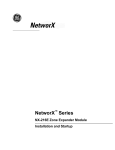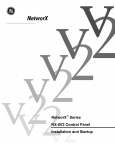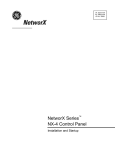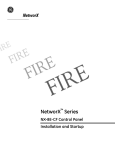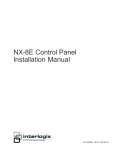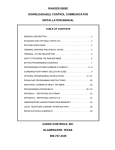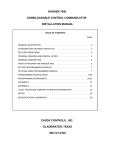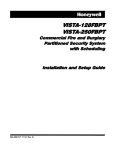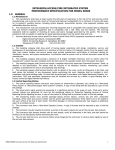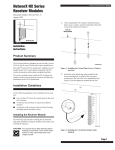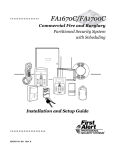Download Wheelock NS-1215W Specifications
Transcript
NetworX™ Series NX-320E REMOTE POWER SUPPLY Installation and Startup © 2005 GE Security All rights reserved. These instructions do not purport to cover all details or variations in equipment nor to provide every possible contingency to be met during installation, operation, and maintenance. If further information is desired or if particular problems arise that are not covered sufficiently for the purchaser’s purpose, the matter should be referred to GE Security, Gladewater, Texas, USA. This document contains proprietary information of GE Security, USA and is furnished to its customer solely to assist that customer in the installation, testing, operations, and/or maintenance of the equipment described. This document shall not be reproduced in whole or in part nor shall its contents be disclosed to any third party without the written approval of GE Security. Please refer to the current GE Security product catalog for detailed warranty information. Main 800-727-2339 Outside the US 903-845-6941 Main Fax 903-845-6811 Web: www.gesecurity.com 2 Technical Support Sales & Literature 888-437-3287 800-547-2556 NX-320E Power Supply TABLE OF CONTENTS I. GENERAL DESCRIPTION..................................................................................... 4 II. ORDERING INFORMATION .................................................................................. 4 III. UNDERWRITERS LABORATORIES INFORMATION........................................... 4 IV. ENCLOSURE DIAGRAM ....................................................................................... 5 V. BATTERY CALCULATION TABLE ....................................................................... 5 VI. TERMINAL DESCRIPTIONS ................................................................................. 6 VII. WIRING REQUIREMENTS .................................................................................... 6 VIII. LAYOUT................................................................................................................. 7 IX. ADDRESSING........................................................................................................ 8 X. ENROLLING .......................................................................................................... 8 XI. UNDERSTANDING THE LEDS ............................................................................. 8 XII. PROGRAMMING ................................................................................................... 9 A. B. C. USING THE LED KEYPAD ............................................................................................................... 9 USING THE LCD KEYPAD ............................................................................................................. 10 PROGRAMMING DATA.................................................................................................................. 10 LOCATION 0 PROGRAMMING EVENT & TIME FOR OUTPUT A ............................ 11 LOCATION 1 PROGRAMMING SPECIAL FEATURES FOR OUTPUT A ................... 12 LOCATION 2 PROGRAMMING THE EVENT & TIME FOR OUTPUT B..................... 12 LOCATION 3 PROGRAMMING SPECIAL FEATURES FOR OUTPUT B ................... 12 LOCATION 4 PROGRAMMING THE EVENT & TIME FOR OUTPUT C .................... 13 LOCATION 5 PROGRAMMING SPECIAL FEATURES FOR OUTPUT C ................... 13 LOCATIONS 6 & 7 RESERVED ......................................................................................... 13 LOCATION 8 CODES 1-10 OUTPUT ENABLE.......................................................... 14 LOCATION 9 CODES 11-20 OUTPUT ENABLE........................................................ 14 LOCATION 10 CODES 21-30 OUTPUT ENABLE........................................................ 14 LOCATION 11 CODES 31-40 OUTPUT ENABLE........................................................ 14 LOCATION 12 CODES 41-50 OUTPUT ENABLE........................................................ 14 LOCATION 13 CODES 51-60 OUTPUT ENABLE........................................................ 14 LOCATION 14 CODES 61-70 OUTPUT ENABLE........................................................ 15 LOCATION 15 CODES 71-80 OUTPUT ENABLE........................................................ 15 LOCATION 16 CODES 81-90 OUTPUT ENABLE........................................................ 15 LOCATION 17 CODES 91-99 OUTPUT ENABLE........................................................ 15 LOCATION 18 A/C DELAY AND DYNAMIC BATTERY TEST ..................................... 15 LOCATION 19 DEVICE OPTIONS............................................................................... 15 XIII. PROGRAMMING WORKSHEETS....................................................................... 16 XIV. SPECIFICATIONS ............................................................................................... 20 NX-320E Power Supply 3 GENERAL DESCRIPTION I. The NX-320E is a microprocessor controlled remote power supply module for the NetworX control panels (refer to Compatibility chart on the back of this manual). This power supply module has three (3) programmable outputs and one (1) dedicated bell output. A maximum of eight (8) power supply modules can be added to the NetworX control panel for a total output count of 32, of which 24 are programmable and 8 are dedicated bell outputs. These 24 programmable outputs can be used as auxiliary power, smoke detector power, siren driver power, etc. (see chart on page 11). Each power supply module has a Tamper terminal that can be used to supervise the metal enclosure. When the power supply module is connected to the NetworX control panel, the maximum total wire run from the panel to all devices, including the NX-320E, is 2500 feet. Additionally, the maximum total wire run from the power supply module to all outgoing devices is 2500 feet. It is not recommended that multiple power supply modules be connected in series (cascaded). ORDERING INFORMATION II. PART # DESCRIPTION PART # NX-320E NX-8 Remote Power Supply NX-8V2 Control Panel only (48 zones) NX-216E NX-408E # NX-8-KIT NX-8V2 Control, NX-108E LED Keypad, & 16.5V 40VA Transformer NX-8 Commercial Fire Control Panel in NX-003-CF Enclosure, (2) NX-148E-CF LCD keypads; NX-870E Fire Supervision module; 16.5V 50VA Transformer NX-8E Control Panel only (192 zones) NX-416E # NX-8-CF-KIT NX-8E NX-448E # NX-508E NX-8E-KIT NX-8E Control, NX-108E LED Keypad, & NX-870E 16.5V 40VA Transformer NX-8E-CF-KIT NX-8E Commercial Fire Control Panel in NX-003-CF NX-003-CF Enclosure, (2) NX-148E-CF LCD keypads; NX-870E Fire Supervision module; 16.5V 50VA Transformer # These wireless devices are UL listed for residential applications only. DESCRIPTION 16 Zone Expander 8 Zone Wireless Expansion Module (UL LISTED PART #60-904) 16 Zone Wireless Expansion Module (UL LISTED PART #60-904) 48 Zone Wireless Expansion Module (UL LISTED PART #60-904) Eight Output Module Fire Supervision Module Commercial Fire Enclosure (Red) Please refer to the GE Security product catalog for warranty details. III. UL365 UL609 UL864 UNDERWRITERS LABORATORIES INFORMATION Police Station Connected Burglar Alarm Units & Systems Local Burglar Alarm Units & Systems Control Units for Fire-Protective Signaling Systems UL985 UL1023 UL1610 Household Fire Warning Systems Household Burglar Alarm Systems Central Station Burglar Alarm Units When the NX-320E Remote Power Supply is used as part of a UL Commercial Fire security system: Unit is compatible with the following devices: o NX-148E-CF LCD keypad o NX-216E Zone Expander o NX-507E Relay Expander o Wheelock NS-1215W or NS-121575W Siren A minimum of 18AWG shall be used for all field wiring. Shielded wire is not recommended. Use a 16.5VAC 50VA / 120V, 60Hz hard-wired transformer (Part #T-0002) 4 NX-320E Power Supply IV. ENCLOSURE DIAGRAM Inside the can, several 2-holed insertion points have been constructed. This allows for either vertical or horizontal placement of the modules. Notice that the insertion points have two sizes of holes -- a larger hole and a smaller hole. Diagram 1: The black plastic PCB guides are grooved on one edge where the PC Board will be seated. The end with the half-moon protrusion fits into the larger hole. The smaller hole is for the screw. Diagram 2: Place the first black plastic PCB guide in the top insertion point, grooved edge downward. The half-moon protrusion will be in the large hole. It does not require force. Insert one of the provided screws into the smaller hole (from inside the can) to secure it in place. A screwdriver should reach through the notch that runs the length of the guide to tighten the screw. The second PCB guide should be positioned opposite of the first (grooved edge up) and placed in the lower insertion point, using the same procedures described above. Once mounted, screw it in securely. Diagram 3: The PC board should slide freely in the grooves of both guides. V. BATTERY CALCULATION TABLE STANDBY TIME 24 hours 48 hours 72 hours NX-320E Power Supply TOTAL AUXILIARY CURRENT 1.9 Amps 1.25 Amps 600 mA 900 mA 600 mA 300 mA 600 mA 400 mA 200 mA STANDBY BATTERY CAPACITY 51 AH 34 AH 17 AH 51 AH 34 AH 17 AH 51 AH 34 AH 17 AH ALARM CURRENT 600 mA 1 Amp 1 Amp 1 Amp 1 Amp 1 Amp 1 Amp 1 Amp 1 Amp 5 VI. TERMINAL DESCRIPTIONS Table VI:1 Terminal Description DATA Connect to the Data terminal of the NetworX control panel (refer to Compatibility chart on the back of this manual). This terminal is the incoming data-signaling terminal to the power supply module. The maximum total wire run from the control panel to all devices, including the NX320E is 2500 feet. COM Connect to the NetworX control panel COMMON terminal. This terminal supplies the common side of the power to the NX-320E board. POS Connect to control panel AUX POWER + terminal. This terminal supplies power to the NX320E board. DATA This terminal is the outgoing data-signaling terminal for buss extension. The maximum total wire run from the NX-320E to all outgoing devices is 2500 feet. COM OUT A Common terminal for any device powered from the NX-320E. Programmable output current limited to 1.9 Amps.Ê OUT B Programmable output current limited to 1.9 Amps. Ê COM OUT C Common terminal for any device powered from the NX-320E. The total current of the Programmable output current limited to 1.9 Amps. Ê NX-320E is 2.5 Amps. ÊÊ Positive of bell output current limited to 2.5 Amps, but 600mA for UL applications. Connect as in diagram on page 7. Negative of bell output current limited to 2.5 Amps, but 600mA for UL applications. Connect as in diagram on page 7. BELL + BELL TAM EARTH AC AC This is an optional tamper terminal. To use this feature, connect the normally closed tamper switch between this terminal and COM. If switch 4 is off, this feature is not used. Earth Ground. AC Input. Connect to a 16.5V 50 VA Class II UL approved transformer. AC Input. Connect to a 16.5V 50 VA Class II UL approved transformer. Ê Total of 1.9 Amps between outputs A,B,C. ÊÊ Total of 2.5 Amps between Bell and outputs. NOTES: Refer to the control panel compatibility chart on the back of this manual. Shielded wire is not recommended. VII. WIRING REQUIREMENTS Table VII:1 For UL COMMERCIAL FIRE installations, a minimum of 18 AWG shall be used for all field-wiring applications, regardless of this chart. 6 LENGTH WIRE GAUGE (IN FEET) WHEN CONNECTED TO NETWORX CONTROL PANEL 400 24 500 24 1000 24 2000 22 2500 20 Note: Shielded wire is NOT recommended. NX-320E Power Supply NX-320E Power Supply UL Installations: The Class 2, Class 3, and powerlimited fire alarm circuits must be installed using FPL, FPLP, FPLR, CL3, CL3R, or CL3P, or substitute cable permitted by National Electrical Code ANSI/NFPA70 and the Class 2, Class 3 and power-limited fire alarm circuit conductors extending beyond the cable jacket must be separated a minimum of ¼ inch or by nonconductive tubing or non-conductive barrier from all other conductors. Recommended: Basler Model BE30614001 120VAC 60Hz 16.5VAC 50VA Class II LED 3 THE BELL OUTPUT IS VOLTAGE ONLY. IT IS PULSED (TEMPORAL) DURING A FIRE ALARM AND STEADY DURING A BURGLAR ALARM. IF THE BELL IS A COMMERCIAL FIRE BELL, THE DIODE (EOL-D5400) IS NOT NEEDED. BATTERY CAPACITY FOR EMERGENCY STANDBY AT LEAST 24 HOURS. CONTROL PANEL DRAWS 50MA STANDBY POWER. BELL CIRCUIT CURRENT LIMITED TO 2.5 AMP MAXIMUM LED 2 CONNECT TO CONTROL PANEL DIP SWITCHES SHIELDED WIRE IS NOT RECOMMENDED. LED 1 VIII. LAYOUT 7 IX. ADDRESSING The first thing that must be decided is the address of this particular power supply. This is the address that will be selected when programming the module. To set the address, use the table below. Dip Switch 4 is used to disable the Tamper feature (“On = enabled / “Off” = disabled). Table IX:1 Address 84 85 86 87 88 89 90 91 X. Dip switch 1 OFF ON OFF ON OFF ON OFF ON Dip switch 2 OFF OFF ON ON OFF OFF ON ON Dip switch 3 OFF OFF OFF OFF ON ON ON ON ENROLLING The NetworX control panel has the ability to automatically find and store in its memory the presence of all keypads, zone expanders, wireless receivers and any other module connected to the data terminal. This allows these modules to be supervised by the control panel. To enroll the modules enter the Program Mode of the NetworX control panel, and when the Program Mode is exited, it will automatically enroll the devices. The enrolling process takes about 12 seconds, during which time the “Service” LED will illuminate. User codes will not be accepted during the enrolling process. Once a module is enrolled, if it is not detected by the control, the “Service” LED will illuminate. XI. UNDERSTANDING THE LEDS The power supply module has four (4) red LEDs, which provide valuable information about its status. The following chart furnishes the indications of each LED. Table XI:1 8 LED Description DS1 Flashes when data is transmitted out from the NX-320E. DS2 Flashes when data is transmitted into the NX-320E. DS3 Flashes during normal operation. DS4 Used for hardware, and will only glow dimly when connected to the NetworX control panel (refer to Compatibility chart on the back of this manual). NX-320E Power Supply XII. PROGRAMMING A. USING THE LED KEYPAD ACTION RESULT 1. Entering the Program Mode Enters the Program Mode. &Á_ Stay, Chime, Exit, Bypass & Cancel LEDS will flash. & Go To Program Code Factory Default is `^XZ If the "Go To Program Code" is valid, the "Service" LED will flash and the 5 function LEDs will illuminate steady. You are now in the Program Mode and ready to select the module to program. 2. Entering the Module Address: &_ ] # (example only) Refer to Table IX:1 on page 8 for the module address. The Armed LED will illuminate while it is waiting for a programming location to be entered. 3. Programming a Location: If an attempt is made to program an invalid entry for a particular segment, the keypad sounder will emit a triple error beep (beep, beep, beep), and remain in that segment awaiting a valid entry. To Enter a Location: & [location] # The Armed LED will flash. If the location is valid, the "Armed" LED will extinguish, the "Ready" LED will illuminate, and the zone LED’s will show the data for the first segment of this location. To Change Location Data: & [changed data] & À The "Ready" LED will flash to indicate a data change in process and will continue until the data is saved. The new data is saved. The keypad will advance to the next segment and display its data. NOTE: These steps are repeated until the last segment is reached. NX-320E Power Supply 9 To Exit a Location: & # Exits from this location. The “Ready” LED will extinguish. The "Armed" LED will illuminate waiting for a new programming location to be entered. To Review The Data: & [location] # & À The Armed LED will flash. If the location number is valid, the "Armed" LED will extinguish, the "Ready" LED will illuminate, and the zone LEDs will show the binary data for the first segment of this location. (Do not enter data.) The next segment is displayed. Each time r is pressed, the data of the next segment will be displayed for review. Shortcuts: & & & Previous location. Same location. Next sequential location. 4. Exiting the Program Mode: & EXIT Exits this programming level. B. USING THE LCD KEYPAD All steps required for programming are the same as the aforementioned LED keypad. The LCD keypad display will prompt you for the data required. While in the programming mode, and not in a location, the number in parenthesis is the location you were previously changing. For example, if the display reads, "Enter location, then # (5)", it is reminding you that location 5 was the last location you programmed. Refer also to "Programming Data" which follows. C. PROGRAMMING DATA Programming data is always one of three types. One type of data is numerical, which can take on values from 0 -15, 0 - F, or 0 - 255 depending on the segment size. The other type of data, feature selection data, is used to turn features on/off. Use the following procedures with these data types: 1. Numerical Data Numerical data is programmed by entering a number from 0-255 on the numeric keys of the system keypad. To view the data in a location, a binary process is used. With this process, the LED=s for zones 1 through 8 are utilized, and the numeric equivalents of their illuminated LED=s are added together to determine the data in a programming location. The numeric equivalents of these LED=s are as follows: Zone 1 LED = 1 Zone 2 LED = 2 10 Zone 3 LED = 4 Zone 4 LED = 8 Zone 5 LED = 16 Zone 6 LED = 32 Zone 7 LED = 64 Zone 8 LED = 128 NX-320E Power Supply Example: If the numerical data to be programmed in a location is "66", press [6]-[6] on the keypad. The LED=s for Zone 2 and Zone 7 will become illuminated indicating 66 is in that location (2 + 64 = 66). Once the data is programmed, press [r] to enter the data and advance to the next segment of that location. After the last segment of a location is programmed, pressing [r] will exit that location, turn the "Ready" LED off, and the "Armed" LED on. As before, you are now ready to enter another programming location. If an attempt is made to program a number too large for a particular segment, the keypad sounder will emit a triple beep, indicating an error, and remain in that segment awaiting a valid entry. 2. Feature Selection Data Feature selection data will display the current condition (on or off) of eight features associated with the programming location and segment selected. Pressing a button on the touchpad (1 thru 8) that corresponds to the "feature number" within a segment will toggle (on/off) that feature. Pressing any numeric key between [1] and [8] for selection of a feature will make the corresponding LED illuminate (feature ON). Press the number again, and the LED will extinguish (feature OFF). You will see that numerous features can be selected from within one segment. For instance, if all eight features of a segment are desired, pressing [1]-[2]-[3]-[4]-[5]-[6]-[7]-[8] will turn on LED's 1 thru 8 as you press the keys, indicating that those features are enabled. LCD Keypad Users Note: The numbers of the enabled features will be displayed. However, the features not enabled will display a hyphen (-). After the desired setting of features is selected for this segment, press [r]. This will enter the data and automatically advance to the next segment of the location. When you are in the last segment of a location and press [r] to enter the data, you will exit that location. This will now turn the "Ready" LED off and the "Armed" LED on. You are now ready to enter another programming location. LOCATION 0 PROGRAMMING EVENT & TIME FOR OUTPUT A (2 segments of numerical data) Segment 1 is used to select the particular event that will trigger Output A. See following chart for the specific events that can be selected. Segment 2 is used to select the amount of time an output will remain activated when an output triggers. If this location is programmed as a zero, the output will follow the particular event. Table XII:1 # Event 0 Always On AC Fail (control or exp.) Does not # 11 Event Smoke Power Reset # 22 Event Disarmed 12 Yelping Siren 23 Ready to Arm 1 follow AC Fail delay time 2 Low Battery (control or exp.) 13 Steady Siren 24 Not Ready to Arm 3 Dynamic Battery Test Time 14 Any Siren 25 Fire 4 Listen In 15 Steady Siren (temporal) 26 Fire Trouble 5 Line Seizure 16 Any Siren (temporal) 27 Chime 6 Telephone Line Fault 17 Alarm Memory 28 Beeping Keypad 7 Program Mode 18 Entry 29 Aux 1 Keypad Function 8 Over-current (control or exp.) 19 Exit 30 Aux 2 Keypad Function 9 Box Tamper (control or exp.) 20 Entry or Exit 31 10 Siren Tamper (control or exp.) 21 Armed 32 Panic Keypad Function Code Entry (set codes in loc 8 – 17) If set to follow condition, these events will be one second. NX-320E Power Supply 11 LOCATION 1 PROGRAMMING SPECIAL FEATURES FOR OUTPUT A (2 segments of feature selection data) Segment 1 selects the following special conditions: 1= 2= 3= 4= 5= 6= 7= 8= "On" if output should time in minutes; "Off" if output times in seconds. "On" if output should latch until a code is entered; “Off” for timed. "On" if output should stop time when a code is entered. “On” for inverted output. “On” disables output during listen-in (only events 12-16). Reserved. Reserved. Reserved. Segment 2 selects the following partitions: 1= 2= 3= 4= 5= 6= 7= 8= "On" if the event should activate when it occurs in Partition 1. "On" if the event should activate when it occurs in Partition 2. "On" if the event should activate when it occurs in Partition 3. "On" if the event should activate when it occurs in Partition 4. "On" if the event should activate when it occurs in Partition 5. "On" if the event should activate when it occurs in Partition 6. "On" if the event should activate when it occurs in Partition 7. "On" if the event should activate when it occurs in Partition 8. LOCATION 2 PROGRAMMING THE EVENT & TIME FOR OUTPUT B (2 segments of numerical data) Segment 1 is used to program the particular event that will trigger Output B. Refer to Table XII:1 on page 11 for the specific events that can be selected. Segment 2 is used to select the amount of time an output will remain activated when an output triggers. If this location is programmed as a zero, the output will follow the particular event. LOCATION 3 PROGRAMMING SPECIAL FEATURES FOR OUTPUT B (2 segments of feature selection data) Segment 1 selects the following special conditions: 1= 2= 3= 4= 5= 6= 7= 8= 12 "On" if output should time in minutes; "Off" if output times in seconds. "On" if output should latch until a code is entered; “Off” for timed. "On" if output should stop time when a code is entered. "On" for inverted output. “On” disables output during listen-in (only events 12-16). Reserved. Reserved. Reserved. NX-320E Power Supply Segment 2 selects the following partitions: 1= 2= 3= 4= 5= 6= 7= 8= "On" if the event should activate when it occurs in Partition 1. "On" if the event should activate when it occurs in Partition 2. "On" if the event should activate when it occurs in Partition 3. "On" if the event should activate when it occurs in Partition 4. "On" if the event should activate when it occurs in Partition 5. "On" if the event should activate when it occurs in Partition 6. "On" if the event should activate when it occurs in Partition 7. "On" if the event should activate when it occurs in Partition 8. LOCATION 4 PROGRAMMING THE EVENT & TIME FOR OUTPUT C (2 segments of numerical data) Segment 1 is used to program the particular event that will trigger Output C. Refer to Table XII:1 on page 11 for the specific events that can be selected. Segment 2 is used to select the amount of time an output will remain activated when an output triggers. If this location is programmed as a zero, the output will follow the particular event. LOCATION 5 PROGRAMMING SPECIAL FEATURES FOR OUTPUT C (2 segments of feature selection data) Segment 1 selects the following special conditions: 1= 2= 3= 4= 5= 6= 7= 8= "On" if output should time in minutes; "Off" if output times in seconds. "On" if output should latch until a code is entered; “Off” for timed. "On" if output should stop time when a code is entered. "On" for inverted output. “On” disables output during listen-in (only events 12-16). Reserved. Reserved. Reserved. Segment 2 selects the following partitions: 1= 2= 3= 4= 5= 6= 7= 8= "On" if the event should activate when it occurs in Partition 1. "On" if the event should activate when it occurs in Partition 2. "On" if the event should activate when it occurs in Partition 3. "On" if the event should activate when it occurs in Partition 4. "On" if the event should activate when it occurs in Partition 5. "On" if the event should activate when it occurs in Partition 6. "On" if the event should activate when it occurs in Partition 7. "On" if the event should activate when it occurs in Partition 8. LOCATIONS 6 & 7 RESERVED NX-320E Power Supply 13 LOCATION 8 CODES 1-10 OUTPUT ENABLE (10 segments of feature selection data) When activating outputs with a user code (event #30), location 8 can be used to restrict certain codes from activating certain outputs. Location 8 contains 10 segments. Segment 1 corresponds to user 1; Segment 10 corresponds to user 10. The LEDs correspond to outputs A - C. Table XII:2 LED LOCATION 9 DESCRIPTION 1 "On" if code will activate Output A; "Off" if it will not. 2 "On" if code will activate Output B; "Off" if it will not. 3 "On" if code will activate Output C; "Off" if it will not. 4 Reserved. CODES 11-20 OUTPUT ENABLE (10 segments of feature selection data) When activating outputs with a user code (event #30), location 9 can be used to restrict certain codes from activating certain outputs. Location 9 contains 10 segments. Segment 1 corresponds to user 11; Segment 10 corresponds to user 20. The LEDs correspond to outputs A - C (see Table XII:2). LOCATION 10 CODES 21-30 OUTPUT ENABLE LOCATION 11 CODES 31-40 OUTPUT ENABLE LOCATION 12 CODES 41-50 OUTPUT ENABLE LOCATION 13 CODES 51-60 OUTPUT ENABLE (10 segments of feature selection data) When activating outputs with a user code (event #30), location 10 can be used to restrict certain codes from activating certain outputs. Location 10 contains 10 segments. Segment 1 corresponds to user 21; Segment 10 corresponds to user 30. The LEDs correspond to outputs A - C (see Table XII:2 on page 14). (10 segments of feature selection data) When activating outputs with a user code (event #30), location 11 can be used to restrict certain codes from activating certain outputs. Location 11 contains 10 segments. Segment 1 corresponds to user 31; Segment 10 corresponds to user 40. The LEDs correspond to outputs A - C (see Table XII:2 on page 14). (10 segments of feature selection data) When activating outputs with a user code (event #30), location 12 can be used to restrict certain codes from activating certain outputs. Location 12 contains 10 segments. Segment 1 corresponds to user 41; Segment 10 corresponds to user 50. The LEDs correspond to outputs A - C (see Table XII:2 on page 14). (10 segments of feature selection data) When activating outputs with a user code (event #30), location 13 can be used to restrict certain codes from activating certain outputs. Location 13 contains 10 segments. Segment 1 corresponds to user 51; Segment 10 corresponds to user 60. The LEDs correspond to outputs A - C (see Table XII:2 on page 14). 14 NX-320E Power Supply LOCATION 14 CODES 61-70 OUTPUT ENABLE LOCATION 15 CODES 71-80 OUTPUT ENABLE (10 segments of feature selection data) When activating outputs with a user code (event #30), location 14 can be used to restrict certain codes from activating certain outputs. Location 14 contains 10 segments. Segment 1 corresponds to user 61; Segment 10 corresponds to user 70. The LEDs correspond to outputs A - C (see Table XII:2 on page 14). (10 segments of feature selection data) When activating outputs with a user code (event #30), location 15 can be used to restrict certain codes from activating certain outputs. Location 15 contains 10 segments. Segment 1 corresponds to user 71; Segment 10 corresponds to user 80. The LEDs correspond to outputs A – C (see Table XII:2 on page 14). LOCATION 16 CODES 81-90 OUTPUT ENABLE LOCATION 17 CODES 91-99 OUTPUT ENABLE (10 segments of feature selection data) When activating outputs with a user code (event #30), location 16 can be used to restrict certain codes from activating certain outputs. Location 16 contains 10 segments. Segment 1 corresponds to user 81; Segment 10 corresponds to user 90. The LEDs correspond to outputs A - C (see Table XII:2 on page 14). (9 segments of feature selection data) When activating outputs with a user code (event #30), location 17 can be used to restrict certain codes from activating certain outputs. Location 17 contains 9 segments. Segment 1 corresponds to user 91; Segment 9 corresponds to user 99. The LEDs correspond to outputs A - C (see Table XII:2 on page 14). LOCATION 18 A/C DELAY AND DYNAMIC BATTERY TEST (2 segments of feature selection data) Location 18 is used to enable the A/C delay and the Dynamic Battery Test, both of which are timed in minutes. The factory default is 5-0, meaning the A/C power will be off for 5 minutes before a report is sent or a Service light will illuminate, and the Dynamic Battery Test is disabled (“0” minutes). If you desire the A/C delay to be 8 minutes and the Dynamic Battery Test to be 3 minutes, you would program [8]-[3]. LOCATION 19 DEVICE OPTIONS (8 segments of feature selection data) Location 19 is used to enable various system features of the power supply module. Table XII:3 LED 1 2 3 4 5-8 Description On for AC report always sent; Off follows control If enabled, an AC Fail report will be sent if power is lost for the time programmed in Location 18. If “off”, the report will only be sent if the control panel has not sent an AC Power Lost report, and AC Fail report is enabled in Location 37 of the panel. On enables periodic Battery Test Enables Battery Missing every 30 seconds. On enables Low Battery reporting If enabled, the power supply module will report Low Battery to the central station. On enables Siren Tamper/Trouble reporting If enabled, the power supply module will report a Siren Tamper to the central station. Reserved NX-320E Power Supply 15 XIII. PROGRAMMING WORKSHEETS (Defaults are printed in bold italics text.) At Default: LOC 0 1 2 3 4 5 6&7 16 Output A = AUX POWER Output B = AUX POWER Output C = SMOKE POWER PAGE DESCRIPTION 11 OUTPUT A EVENT & TIME 12 OUTPUT A SPECIAL FEATURES Segment 1 1 = "On" if timed in minutes; "Off" if timed in seconds. 2 = "On" if latched until code is entered; “Off” for timed. 3 = "On" if output should stop time when a code is entered. 4 = "On" for inverted output. 5 = “On” disables output during listen-in. 6-8 = Reserved 12 OUTPUT B EVENT & TIME 12 OUTPUT B SPECIAL FEATURES Segment 1 1 = "On" if timed in minutes; "Off" if timed in seconds. 2 = "On" if latched until code is entered; “Off” for timed. 3 = "On" if output should stop time when a code is entered. 4 = "On" for inverted output. 5 = “On” disables output during listen-in. 6-8 = Reserved. 13 OUTPUT C EVENT & TIME 13 OUTPUT C SPECIAL FEATURES Segment 1 1 = "On" if timed in minutes; "Off" if timed in seconds. 2 = "On" if latched until code is entered; “Off” for timed. 3 = "On" if output should stop time when a code is entered. 4 = "On" for inverted output. 5 = “On disables output during listen-in. 6-8 = Reserved. 13 RESERVED DEFAULT 0 10 Segment 2 1 = Partition 1 2 = Partition 2 3 = Partition 3 4 = Partition 4 0 10 Segment 2 1 = Partition 1 2 = Partition 2 3 = Partition 3 4 = Partition 4 11 8 Segment 2 1 = Partition 1 2 = Partition 2 3 = Partition 3 4 = Partition 4 DATA _ _ 5 = Partition 5 6 = Partition 6 7 = Partition 7 8 = Partition 8 _ _ 5 = Partition 5 6 = Partition 6 7 = Partition 7 8 = Partition 8 _ _ 5 = Partition 5 6 = Partition 6 7 = Partition 7 8 = Partition 8 NX-320E Power Supply LOC 8 PAGE 14 9 14 10 14 11 14 12 14 13 14 14 15 15 15 16 15 17 15 NX-320E Power Supply DESCRIPTION Codes 1-10 Output Enable (Circle the numbers to program) User 1 2 3 4 5 6 1 1 1 1 1 1 Output #A 2 2 2 2 2 2 Output #B 3 3 3 3 3 3 Output #C Codes 11-20 Output Enable (Circle the numbers to program) User 11 12 13 14 15 16 1 1 1 1 1 1 Output #A 2 2 2 2 2 2 Output #B 3 3 3 3 3 3 Output #C Codes 21-30 Output Enable (Circle the numbers to program) User 21 22 23 24 25 26 1 1 1 1 1 1 Output #A 2 2 2 2 2 2 Output #B 3 3 3 3 3 3 Output #C Codes 31-40 Output Enable (Circle the numbers to program) User 31 32 33 34 35 36 1 1 1 1 1 1 Output #A 2 2 2 2 2 2 Output #B 3 3 3 3 3 3 Output #C Codes 41-50 Output Enable (Circle the numbers to program) User 41 42 43 44 45 46 1 1 1 1 1 1 Output #A 2 2 2 2 2 2 Output #B 3 3 3 3 3 3 Output #C Codes 51-60 Output Enable (Circle the numbers to program) User 51 52 53 54 55 56 1 1 1 1 1 1 Output #A 2 2 2 2 2 2 Output #B 3 3 3 3 3 3 Output #C Codes 61-70 Output Enable (Circle the numbers to program) User 61 62 63 64 65 66 Output #A 1 1 1 1 1 1 Output #B 2 2 2 2 2 2 Output #C 3 3 3 3 3 3 Codes 71-80 Output Enable (Circle the numbers to program) User 71 72 73 74 75 76 Output #A 1 1 1 1 1 1 Output #B 2 2 2 2 2 2 Output #C 3 3 3 3 3 3 Codes 81-90 Output Enable (Circle the numbers to program) User 81 82 83 84 85 86 Output #A 1 1 1 1 1 1 Output #B 2 2 2 2 2 2 Output #C 3 3 3 3 3 3 Codes 91-99 Output Enable (Circle the numbers to program) User 91 92 93 94 95 96 Output #A 1 1 1 1 1 1 Output #B 2 2 2 2 2 2 Output #C 3 3 3 3 3 3 7 1 2 3 8 1 2 3 9 1 2 3 10 1 2 3 17 1 2 3 18 1 2 3 19 1 2 3 20 1 2 3 27 1 2 3 28 1 2 3 29 1 2 3 30 1 2 3 37 1 2 3 38 1 2 3 39 1 2 3 40 1 2 3 47 1 2 3 48 1 2 3 49 1 2 3 50 1 2 3 57 1 2 3 58 1 2 3 59 1 2 3 60 1 2 3 67 1 2 3 68 1 2 3 69 1 2 3 70 1 2 3 77 1 2 3 78 1 2 3 79 1 2 3 80 1 2 3 87 1 2 3 88 1 2 3 89 1 2 3 90 1 2 3 97 1 2 3 98 1 2 3 99 1 2 3 17 LOC 18 PAGE 15 19 15 18 DESCRIPTION A/C Delay (in minutes) Dynamic Battery Test (in minutes) Device Options (Circle the numbers to program) 1=On for AC report always sent; Off follows control 2=On enables periodic battery test 3=On enables low battery reporting 4=On enables siren tamper/trouble reporting DEFAULT 5 0 DATA ___ ___ 5=Reserved 6=Reserved 7=Reserved 8=Reserved NX-320E Power Supply NOTES NX-320E Power Supply 19 XIV. SPECIFICATIONS NX-320E DIMENSIONS 2.0” Wide 9.0” High 4.0” Deep CURRENT DRAW AC Input: 120V, 60Hz, 650mA 10 mA Standby 16.5 VAC 50 VA Transformer AUXILIARY POWER Limited to 2.5 Amps with 50 VA 12V DC, BATTERY 51Ah for 24 hrs of battery backup 3 – 17 Ah in parallel OPERATING TEMPERATURE 32 to 120 degrees F SHIPPING WEIGHT 8 lbs. COMPATIBLE CONTROL PANELS: NX-8 or NX-8V2 NX-8-CF NX-8E NX-8E-CF 48 zone Household Fire & Burglary, Commercial Burglary control 48 zone Commercial Fire control 192 zone Household Fire & Burglary, Commercial Burglary control 192 zone Commercial Fire control Main 800-727-2339 Outside the US 903-845-6941 Web: www.gesecurity.com NX320EIG05 REV G (June 2005) Technical Support Sales & Literature 888-437-3287 800-547-2556




















